Project background
The past 30 years have seen rapid and large scale declines in the populations of many species of sharks and rays globally. Of the 1150 known species that have been assessed, over a quarter are now threatened with extinction, and much of the public is generally indifferent or unsupportive of their conservation. MarAlliance, with the support of the Wildlife Conservation Network, is working to change that.
Working globally with a particular focus on the Mesoamerican Reef, MarAlliance explores, enables and inspires positive change for threatened marine wildlife, their critical habitats, and dependent human communities. No better microcosm of these threats exists than in Belize, a small tropical country along the Mesoamerican Reef, the second longest barrier reef in the world. Here, sharks bring in millions of dollars in tourism annually, yet they are still unsustainably fished for export to neighboring countries. New approaches to conservation stewardship are needed to address these issues.
MarAlliance is asking the tourism sector and the country’s visitors to step up to demonstrate that live sharks and rays are worth far more alive than dead – they are key to generating renewable income and engaging tourists. Our proposed “citizen science” project will engage tourists and tour operators, fishers, decision-makers, and students to change attitudes – we aim to turn them into shark stewards and help to reverse the decline in sharks and rays.
Project report
We accomplished a large portion of our proposed project but suffered considerable delays in the implementation of the citizen science component due to the difficulty in finding a reliable partner and platform. This was resolved with the contracting of the application development partner Spotteron, which happened directly prior to the impact of COVID-19 on national and global economies and travel. Due to the pandemic, the next phase of the project has been put on hold, but we have been able to make significant progress to lay the groundwork for developing a smartphone app, as summarized here:
Engaging the community
To disseminate information on the value of live sharks, our strategy was to reach guides and businesses engaged directly in the tourism industry as well as students, many of whom will likely enter the sector following graduation. From our base in San Pedro, Ambergris Caye, we held regular meetings with top dive shops in Ambergris Caye and Caye Caulker (where the majority of shark tourism stems from). To keep sharks and rays front and center in people’s minds and to curry pride for these species, we distributed 15 sets of waterproof Sharks and Rays of Belize and Shark Anatomy posters produced by MarAlliance to dive shops for prominent placement and reference.
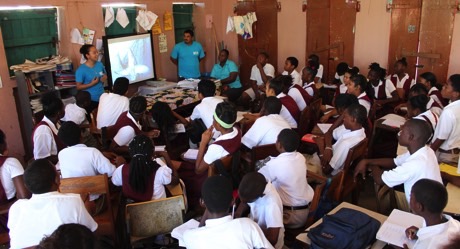
To engage local families and students, many of whom are directly or indirectly involved in the tourism industry, we visited 60 schools in Belize, reaching 1,696 students, by conducting presentations on sharks and rays. The schools visited included San Pedro in Ambergris Caye, Corozal, Orange Walk, Belize City, Cayo, and Dangriga. We also had educational booths during the annual Oceana Reef Fair held in Orange Walk, at the San Pedro RC school environmental fair, and the annual Centro Escolar Junior College Open Day, to engage the public and educate about sharks and rays. We also taught relevant courses in August as part of the Marine Conservation Summer Camp created by the Program Coordinator of the Clearwater Marine Aquarium Research Institute and a Caye Caulker-based National Geographic Student Expedition.
Building tourism sector support
To engage the tourism sector in supporting shark conservation and create national pride and stewardship for sharks and rays through the implementation of an annual shark and ray count in Belize.
We held meetings with the Hol Chan Marine Reserve staff, and the owners and guides of the seven major dive shops on San Pedro and Caye Caulker to:
- discuss steps to improve shark conservation in Belize; and
- determine interest and parameter of a smartphone-based application to help log sightings of sharks and rays, an annual shark count day, to raise the profile of these taxa, and promote their value alive rather than as part of the fishery trade, which benefits few.
Our goals were to:
- test the abilities of visitors and guides to contribute to and engage in the long-term monitoring and conservation of sharks and rays through imagery and data capture using a dedicated app; and
- test our our ability to define individual sharks and rays.
We conducted monitoring of the best-known aggregation of shark and ray populations in Belize at the Shark and Ray Alley (SRA) in the Hol Chan Marine Reserve (HCMR).
Our approach was simple and robust: we used commercially available GoPro cameras to take video and extract side images of the two nurse shark dorsal fins to identify individuals by fin size, shape and scarring characteristics, and used a special frame with fixed lasers and a GoPro camera for size estimation to compare with visual estimations. We looked at the ease of robustly determining sex, and conducted drone-assisted visual counts of sharks and rays at the aggregation.
We trained five interns and conducted a total of 34 snorkel surveys with park rangers and tourism businesses, and undertook two aerial drone surveys. Data analysis yielded 106 individual nurse sharks identified using fin identification methods with the Darwin software.
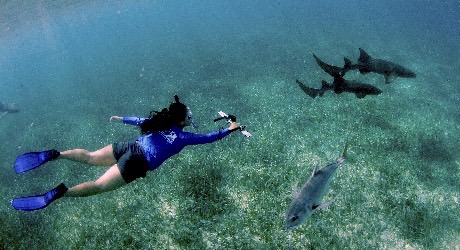
Surveying shark operators
Forty-seven tour operators participated in the survey. The largest number (51%) were located in San Pedro, followed by Caye Caulker (21%) and Placencia (17%). Two operators (4%) were located in Hopkins and one each in Belize City, Monkey River, and Sitte River. The operators reported employing 111 dive masters and 45 instructors. There were also 26 tour guides employed by the operators that did not have dive masters or instructors. In total, the companies employed 170 people to carry out the tours. These companies often also employ office staff; making the total employment higher. All but three tour operators (94%) offered shark tours.
On average, annually, the operators took out 1,894 divers and 66,501 snorkelers. The number of divers ranged from 0 to 21,900 with an average of 1,894; and snorkeler numbers ranged from 0 to15,000 with an average of 1,663. Combined, the responding operators (n=39) took out 75,748 divers and 66,501 snorkelers annually. Combined, the tour operators reported running 725 tours/month and 7731 tours/year. These tours took a total of 3,888 guests/month and 41,144 guests/year. The operators reported their most popular tour (63.85%) was to Hol Chan Marine Reserve/Shark Ray Alley (HCMR/SRA). This was also the least expensive tour at an average cost of US$142.82. Gladden Spit/Silk Cayes was the second most popular tour (average cost $243.57) with whale sharks as the primary attraction.
The tour price included the park fee (US$10 for Hol Chan Marine Reserve and Gladden Spit, and US$40 for Blue Hole/Lighthouse Reef Atoll) for 62% of tour operators. More than four-fifths (83%) of the operators also reported that guests asked and/or hoped to see rays or sharks, other than whale sharks, during the tour. For those operators that responded yes, an average of 52% of their guests asked (range 5 to 100%). Most guests (64%) just wanted to see a shark, and nurse (28%) and reef (21%) sharks were the next-most commonly requested shark sighting opportunities.
We also asked tour operators several questions on the importance of sharks, other than whale sharks, to their businesses. The majority (55%) of the surveyed operators responded that sharks (other than whale sharks) were “very important” to their businesses. Revenue derived from non-whale shark tours averaged 45%. In regards to whale sharks, only eight operators reported any revenue from these tours.
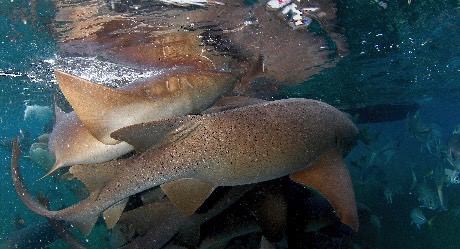
Finally, we attempted to estimate the value of sharks to Belize’s tourism industry using two methods:
- using the data provided by the tour operators for this survey; and
- using the number of entries to the three parks.
The first method revealed a value of US $23,153,669.20, and the second method reported a value of US $5,717,731.60. Research conducted in 2007 by MarAlliance’s Dr. Rachel Graham valued the shark fishery in Belize yielding nearly $2 million per annum in non-renewable revenue recognized by 95 fishers. Our surveys clearly demonstrate that sharks are worth more alive than dead as a renewable resource to the Belizean economy. Note these figures do not take into account the ecosystem benefits that sharks provide while living in the waters off Belize. This data is to be disseminated along with the app once launched.
What next?
We have yet to complete and launch the application with the help of media and the broad engagement of the tourism industry. Our project was upended at a critical period in its development due to COVID-19, and taking measures to ensure the survival of our NGO has taken precedence. Travel is restricted within Belize and will be restricted internationally for months to come. All partner meetings, tourism activities, international flights, on-water activities, and education have been prohibited, and reopening will be very gradual to minimize potential infections as Belize does not have a robust medical system. We have stabilized our NGO but have lost personnel which will limit our ability to engage with partners when tourism reopens. In the meantime, we will continue to work on the app and figure out the best roll-out strategy in light of a different world than when we started the project.
Thankfully, we now have a precedent in Belize that has been established in the birding sector – a dedicated birding day and festival was successfully created in 2019 and can be replicated as a template for a fish (but not called “fishing”!) day.
Can I visit the project?
Hopefully, following the resumption of international travel and the app launch in Belize we hope later this year, then absolutely, we look forward to visits! We also hope to replicate the app in other countries including Honduras and Panama where we have programs, so you would have multiple sites to visit.
Project Background
The past 30 years have seen rapid and large scale declines in the populations of many species of sharks and rays globally. Of the 1150 known species that have been assessed, over a quarter are now threatened with extinction, and much of the public is generally indifferent or unsupportive of their conservation. MarAlliance, with the support of the Wildlife Conservation Network, is working to change that.
Working globally with a particular focus on the Mesoamerican Reef, MarAlliance explores, enables and inspires positive change for threatened marine wildlife, their critical habitats, and dependent human communities. No better microcosm of these threats exists than in Belize, a small tropical country along the Mesoamerican Reef, the second longest barrier reef in the world. Here, sharks bring in millions of dollars in tourism annually, yet they are still unsustainably fished for export to neighboring countries. New approaches to conservation stewardship are needed to address these issues.
MarAlliance is asking the tourism sector and the country’s visitors to step up to demonstrate that live sharks and rays are worth far more alive than dead – they are key to generating renewable income and engaging tourists. Our proposed “citizen science” project will engage tourists and tour operators, fishers, decision-makers, and students to change attitudes – we aim to turn them into shark stewards and help to reverse the decline in sharks and rays.
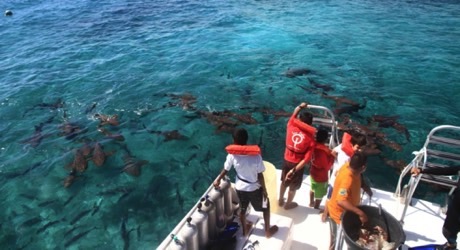
Project Overview
Our long term goal is to stem the decline of shark and ray populations in Belize. Our goal for this project is to fully engage the tourism sector to advocate for the conservation of sharks. There are three key objectives to meeting this goal:
- To disseminate information on the value of live sharks
- To engage the tourism sector in supporting shark conservation
- To create national pride and stewardship for sharks and rays through the implementation of an annual shark and ray count in Belize
To achieve these, we will conduct a series of media campaigns (based on the results of our national survey) – the goal of these campaigns is to show that sharks are worth more alive than dead. The audiences will be the tourism sector, the fisheries industry, local students, and decision-makers.
By informing and engaging visitors and locals about good tourism and conservation practices with respect to sharks and rays, we help to shape a future for the conservation of sharks and rays in Belize. From this platform, we will then work to engage people from all of these sectors in a national citizen science project: conducting the Caribbean’s first shark and ray count in Belize (similar to the annual Audubon backyard bird-count or Christmas count and the Fiji shark count).
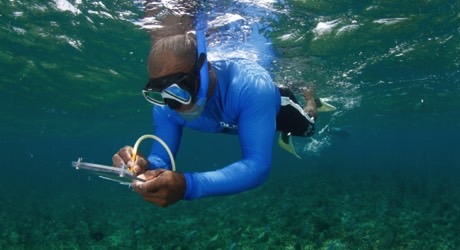
What's Covered in Project Cost
- Analysis of survey data about the value of live sharks
- Design and print posters, boat stickers for all tour operators, schools, and businesses and project t-shirts
- Development of videos to explain how to participate in the citizen science project
- Create and run an online platform to manage incoming citizen science data
- Stipends for local interns
- Meetings in eight large coastal communities to bring together representatives from tourism, government, schools and NGO partners
- Meetings of stakeholders and media to develop the project with maximum media reach and assessment of impact post campaign and annual count.
Partners and Community Involvement
The project will primarily involve:
- The tourism community (guides, operators, and government oversight)
- Select school teachers who have been involved in our Kids Meet Sharks program
- Colleagues from local NGOs who will be trained in how to collect and submit data and engage others – notably friends, colleagues and visitors – to do the same.
Top shark and ray operators will be highlighted on the project website. Specifically, we will work with the top shark and ray operators in-country, including Amigos del Mar, Ramon’s Dive Shop, Belize Pro Dive, Belize Diving Adventures, Belize Diving Services, Frenchie’s, Hamanasi, Seahorse, Sea Sports, Huracan, and Splash dive shop across the main dive and snorkel tourism centers in San Pedro, Caye Caulker, Hopkins and Placencia.
Our primary government and NGO counterparts include the Hol Chan Marine Reserve staff, the Belize Tourism Industry Association, The Belize Tourism Board, the Belize Audubon Society, and Southern Environmental Association. To get the message out widely we will work with Belize’s news media channels who have supported our work and focus on morning show appearances and news pieces that have been well received.
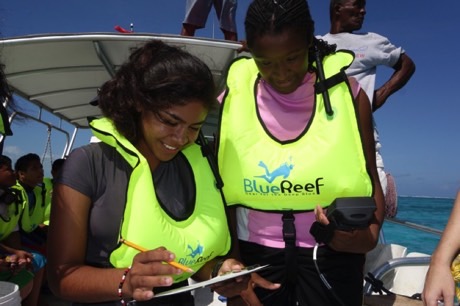
Part of a Larger Strategy
This project will help us to broadly engage with the tourism sector in a more dynamic and effective way – to date, our work has mostly focused on science, policy, conservation, and education of primary school children, but it is crucial for us to work to engage the tourism sector as well since they have a direct impact on these animals. With shark numbers continuing to decline and fisheries still permitted, the tourism sector is going to play a critical role in reversing declines as this is the highest foreign exchange earner in Belize. This project will enable us to engage with a key audience to highlight the value of live sharks and rays to the country and reef ecosystems.
This project provides excellent value for money as the large-scale national survey was completed and all data entered. Strong relationships have been forged throughout the tourism industry; tour operators and visitors are keen to see more protection enacted and are looking for a means to be engaged that further improves Belize’s profile for shark tourism.